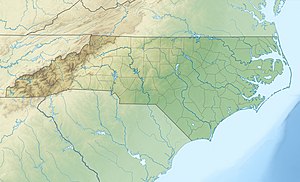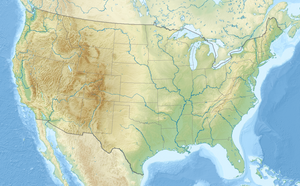Skin Cabin Creek
Appearance
| Skin Cabin Creek Tributary to Ararat River | |
|---|---|
| Location | |
| Country | United States |
| State | North Carolina |
| County | Surry |
| Physical characteristics | |
| Source | divide of unnamed tributary to Ararat River |
| • location | pond at Pine Hill, North Carolina |
| • coordinates | 36°21′02″N 080°34′52″W / 36.35056°N 80.58111°W[1] |
| • elevation | 1,110 ft (340 m)[2] |
| Mouth | Ararat River |
• location | about 3 miles southeast of Pine Hill, North Carolina |
• coordinates | 36°20′01″N 080°32′50″W / 36.33361°N 80.54722°W[1] |
• elevation | 815 ft (248 m)[2] |
| Length | 3.34 mi (5.38 km)[3] |
| Basin size | 2.84 square miles (7.4 km2)[4] |
| Discharge | |
| • location | Ararat River |
| • average | 4.10 cu ft/s (0.116 m3/s) at mouth with Ararat River[4] |
| Basin features | |
| Progression | Ararat River → Yadkin River → Pee Dee River → Winyah Bay → Atlantic Ocean |
| River system | Yadkin River |
| Tributaries | |
| • left | unnamed tributaries |
| • right | unnamed tributaries |
| Bridges | Stanford Church Road |
Skin Cabin Creek is a 3.34 mi (5.38 km) long 1st order tributary to the Ararat River in Surry County, North Carolina. This is the only stream of this name in the United States.[1]
Course
[edit]Skin Cabin Creek rises in a pond on the divide of an unnamed tributary to the Ararat River at Pine Hill, North Carolina. Skin Cabin Creek then flows south and then east to join the Ararat River about 3 miles southeast of Pine Hill.[2]
Watershed
[edit]Skin Cabin Creek drains 2.84 square miles (7.4 km2) of area, receives about 47.5 in/year of precipitation, has a wetness index of 314.53, and is about 62% forested.[4]
See also
[edit]References
[edit]- ^ a b c "GNIS Detail - Skin Cabin Creek". geonames.usgs.gov. US Geological Survey. Retrieved 21 September 2020.
- ^ a b c "Skin Cabin Creek Topo Map in Surry". TopoZone. Locality, LLC. Retrieved 21 September 2020.
- ^ "ArcGIS Web Application". epa.maps.arcgis.com. US EPA. Retrieved 21 September 2020.
- ^ a b c "Skin Cabin Creek Watershed Report". US EPA Geoviewer. US EPA. Retrieved 21 September 2020.


